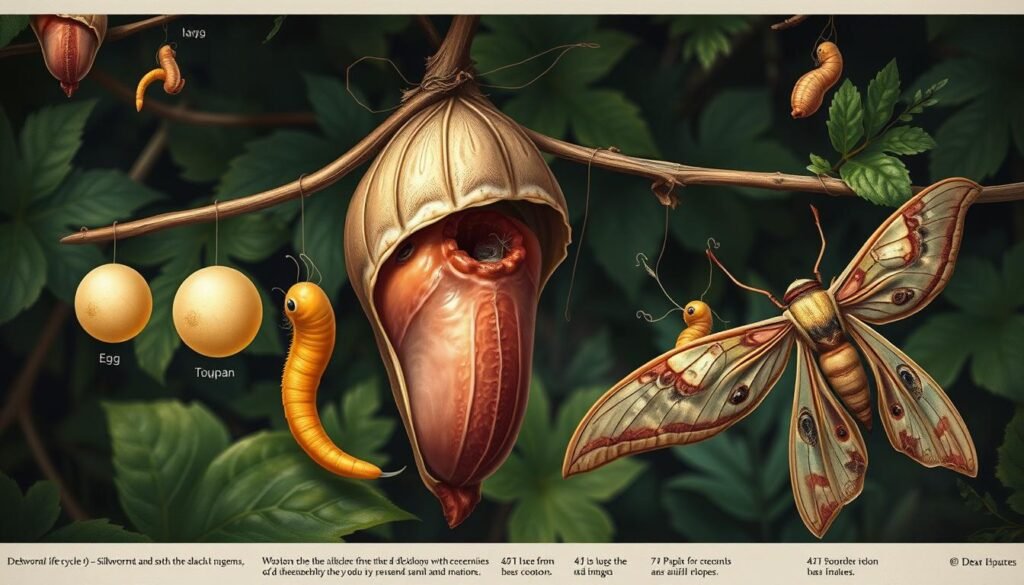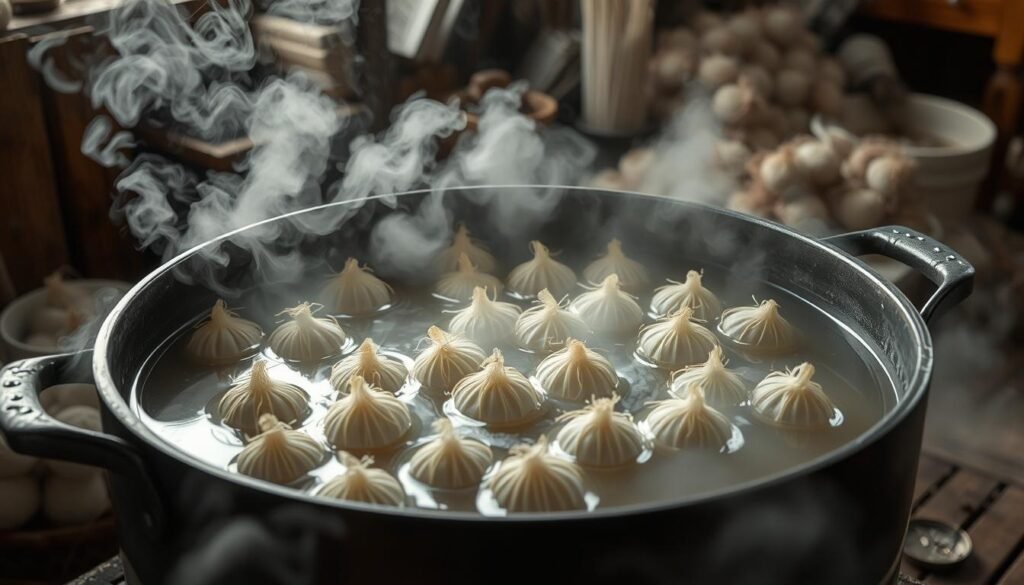Ever wondered how silk goes from a silkworm’s cocoon to the luxurious fabric we love? This guide will take you through the detailed steps of making silk. Get ready to see the amazing work and care in creating this special fabric.
Key Takeaways
- Silk production is a labor-intensive and costly process, with the average pound of raw silk requiring around 2,500 silkworm cocoons1.
- Silk is not limited to clothing and textiles – it’s also used in medical supplies, bike tires, and other products2.
- Vegan alternatives to traditional silk, such as lotus silk, bamboo silk, and ramie, are gaining popularity as sustainable options2.
- The silk reeling and finishing processes play a crucial role in determining the final quality and properties of the fabric1.
- Proper disposal of chemically manufactured silk alternatives like bamboo silk is essential to mitigate environmental impact2.
Join us as we explore the journey of silk, from the silkworm to the fabric we all know. What makes silk so special and timeless? Let’s dive into the process and find out.
Introduction to Silk Production
Silk is a stunning, soft, and shiny fabric that has amazed people for thousands of years. It has a history over 5,0003. This beautiful material is seen as one of the most valuable and luxurious in the world. Even today, making silk still uses old methods3.
Silk: A Luxurious and Timeless Fabric
Silkworms, or Bombyx mori, are at the center of silk making. They can spin a single, long silk filament1. This skill makes silk shiny and strong. Silkworms spin their cocoons, making about 100 meters of silk each1.
The Role of Silkworms in Silk Manufacturing
Silkworms play a big part in making silk1. It takes about 2,500 cocoons to make one pound of raw silk. This shows how hard and detailed the process is1. One cocoon can make 1,000 to 2,000 feet of silk. Most of it is fibroin and some is sericin1. To make one yard of silk, you need 3,000 cocoons1.
The silkworm’s skill in spinning silk is amazing. Its ability to make a long, continuous filament is key to silk’s beauty and lasting value14.
Sericulture: The Cultivation of Silkworms
Raising silkworms to make silk is a long tradition. Silk production starts with the silkworm, or Bombyx mori. This name means “silkworm of the black mulberry tree.”5
The Life Cycle of a Silkworm
The silkworm’s life is interesting, starting as an egg that turns into a larva. These young ones are fed mulberry leaves. They grow and shed their skin many times before turning into a pupa and spinning cocoons6.
When they spin cocoons, silkworms move in a figure-eight pattern. This makes a long silk filament, up to 1,600 meters long5.
Rearing and Feeding Silkworms
Silkworms eat a lot of mulberry leaves for about a month6. They need the right temperature, humidity, and air to grow well6.
| Key Stages of Silkworm Life Cycle | Duration |
|---|---|
| Egg hatching into larvae | 14 days on average5 |
| Larval to pupal phase | 12 days on average5 |
| Lifespan of a silk moth | 5 to 10 days5 |
| Time to harvest silkworm cocoons | 7-8 days after spinning5 |

“Sericulture is a delicate and intricate process that requires meticulous attention to detail at every stage, from the cultivation of silkworms to the extraction of the precious silk filaments.”
Harvesting and Stifling the Silk Cocoons
After the silkworms spin their cocoons, it’s time to harvest them7. This is done by hand to keep the silk fibers safe7. Then, the pupae inside must be killed, a step called stifling7. This is done with hot air or steam, drying the cocoons for longer storage7.
The cocoons are sorted by quality, length, color, and shine7. Sorting is key for top-quality silk, as different silks have unique traits7. For example, Mulberry Silk is yellow or green, while Eri Silk is creamy-white or red7.
Some worry about the welfare of the silkworms during stifling7. But this step stops moths from coming out and ruining the silk7. Silkworms can get sick or infested, so they need careful care for healthy silk production7.
| Silk Type | Color | Characteristics |
|---|---|---|
| Mulberry Silk | Yellow/Green | Most common and widely produced silk |
| Eri Silk | Creamy-White/Brick-Red | Unique to Northeast India, known for its durability |
| Tasar Silk | Copper-Brown | Wild silk produced by the Tasar silkworm, found in Central and Eastern India |
| Muga Silk | Golden | Exclusive to Northeast India, known as the “golden thread” |
Silk is big in countries like8 India, the second-biggest silk producer after China8. In India, mulberry silk makes up most of the country’s silk8. India is the only place making all four main silk types: Mulberry, Eri, Muga, and Tasar8.
Women, especially from poor areas, work in the silk industry in India8. This work helps these communities a lot, showing silk’s big role in their culture and economy.
“Silk production is not just an industry – it’s a way of life that has been passed down through generations in many parts of the world, particularly in Asia. The intricate process of harvesting and stifling the silk cocoons is a testament to the skill and dedication of the people involved.”
Learning about harvesting and stifling helps us value the effort and skill in making silk. Choosing a good silk maker is key for quality silk products78.
Boiling and Deflossing the Cocoons
The silk production process changes a lot with boiling and deflossing the cocoons. This step is key for getting the silk fibers ready for reeling9.
Boiling the cocoons makes the silk fibers soft and starts the silk-making process. It removes sericin, a sticky protein, from the fibers. This makes the silk soft and smooth10.
Preparing the Cocoons for Reeling
After boiling, the cocoons go through deflossing. This means brushing off loose and broken silk fibers. It gets the cocoons ready for reeling9.
The cocoons should have a shell ratio of 12-24% for best silk production9. Keeping the cocoons at 27°C is also important9.
This careful prep makes sure the silk fibers are even and ready for reeling. In reeling, the fibers are taken out of the cocoons9.

“The art of sericulture has been passed down through generations, and the techniques for boiling and deflossing the cocoons have remained relatively unchanged over time, despite advancements in technology.”11
The silk production process has changed, but boiling and deflossing the cocoons are still key. They turn the delicate silk fibers into the luxurious fabric we love11.
Reeling: Unwinding the Silk Filaments
The silk reeling process turns cocoons into silk yarn strands. It’s a detailed process. Artisans unravel the silk filament from cocoons and wind several together to make a strand12. Now, machines do most of this work, making it faster and more efficient.
These machines use brushes to grab the silk filament and unwind the cocoon quickly. They also dry the silk as they go12. To make a single strand of silk yarn, they use 2 to 20 cocoon fibers12.
Over time, the silk reeling process has changed a lot. Old silk mills were found in places like Lyon, Genoa, and Valencia13. Now, most are in places like China and India, where silk is made naturally13.
| Silk Reeling Fact | Statistic |
|---|---|
| Average Length of a Silk Filament | 1,000 meters, nearly equivalent to 11 American football fields lined up end to end13 |
| Silk Threads Composition | 6 to 8 silk filaments from different cocoons, with slight variability in thickness due to the manual process of joining individual filaments13 |
| Silk Thread Thickness Labeling | The Indian system considers variations in thread thickness, with markings like 20/22 indicating the allowable range of thickness variations13 |
The silk reeling process is a detailed dance. Skilled artisans turn cocoons into the luxurious silk we love.
Step-by-Step Guide: How Silk Is Made Into Fabric
The process of making silk fabric is fascinating. It starts with reeling the silk yarns. Then, they are dyed to get the right colors14. The yarns sit in dye for about an hour14. After dyeing, they are spun onto bobbins for weaving.
There are many ways to weave silk yarns into fabric. Techniques like the charmeuse or satin weave make silk look smooth and shiny14. Satin, open, and plain weaves are the most common types14. Sometimes, silk fabric gets extra treatments like printing to make it better for different uses.
Making silk fabric shows the skill and creativity of silk makers14. China leads in silk production, followed by Japan and India1415. In India, six states produce raw mulberry silk: Andhra Pradesh, Karnataka, Jammu and Kashmir, Tamil Nadu, Bihar, and West Bengal15. This expertise makes silk a favorite fabric worldwide.
| Silk Weaving Technique | Characteristics |
|---|---|
| Charmeuse Weave | Soft, lightweight, and lustrous appearance |
| Satin Weave | Smooth, shiny, and reflective surface |
| Plain Weave | Simple, sturdy, and versatile fabric structure |
14 Digital printing is the top choice for silk designs, while screen printing is traditional14. The making of silk fabric shows the deep history and new techniques behind this beautiful fabric141615.
Dyeing and Coloring Silk Yarns
Traditional and Modern Dyeing Techniques
Turning silk filaments into colorful fabrics is key in silk making. Silk yarns soak in a Synthrapol bath for 4-5 days to absorb dye well17. Before, silk makers used natural dyes from plants and fruits, like indigo leaves, for unique colors18. This method gives beautiful, one-of-a-kind colors and supports eco-friendly silk making.
Now, silk makers often use synthetic dyes like acid or reactive dyes for more colors and quicker production19. They use 1.5-2% dye powder by fiber weight and soak the yarn for 12-24 hours for better color17. Keeping the water under 180 degrees Fahrenheit helps keep the silk yarn’s shine17.
Every dyeing method aims to soak the yarn in dye to color it19. Colors like blues, pinks, and blacks might not fully dye17. Letting the yarn cool overnight helps keep the color17. Rinse the yarn in cool water until it’s clear, and air dry it to keep the color17.
Whether it’s traditional or modern methods, silk dyeing is a fascinating art. It turns simple yarn into a luxurious, colorful fabric. This has made silk a favorite among weavers, designers, and fashion lovers18.
Spinning Silk Yarns for Weaving
After dyeing, silk yarns need to be spun for weaving. This means winding the fibers onto bobbins, either by hand or with machines. This makes a flat, uniform thread ready for weaving20. The traditional spinning wheel helps in this process, by unwinding and laying the fibers flat21.
The final fabric’s weight and thickness depend on how many silk threads are woven together. More threads make the fabric heavier and less smooth20. Even with modern tech, traditional silk spinning is still key21.
Spinning silk yarn is vital for making the luxurious fabric we all love20. By preparing the fibers well, weavers can make beautiful silk textiles. These textiles are known for being soft, durable, and beautiful21.
FAQ
What is the role of silkworms in the silk manufacturing process?
Silkworms, or Bombyx mori, are key in making silk. They produce the silk fibers. These fibers are then turned into the beautiful silk fabric we know.
How are silkworms reared and fed in the sericulture process?
Silkworms start as eggs that hatch into caterpillars. They are fed mulberry leaves carefully. As they grow, they shed their skin several times before spinning cocoons.
What happens after the silkworms have spun their cocoons?
After spinning, the cocoons are harvested by hand. This ensures the silk fibers are not damaged. The pupae inside are then killed to dry the cocoons for longer preservation.
How are the silk cocoons prepared for the reeling process?
The cocoons are boiled to soften the silk fibers. This makes it easier to find the silk filament. Boiling also removes sericin, a gummy protein. Then, deflossing removes loose fibers, preparing the cocoons for reeling.
What is the reeling process, and how is it carried out?
Reeling turns cocoons into silk yarn. It involves unraveling the silk filament and winding several together. This was once done by hand but is now automated with machines.
How are the silk yarns dyed and colored?
Silk filaments are dyed to get the desired colors. Traditional methods use natural dyes from plants. Now, synthetic dyes are also used for a wider range of colors and faster production.
What is the spinning process for silk yarns, and how does it prepare them for weaving?
After dyeing, silk yarns are spun for weaving. They are wound onto bobbins, either by hand or with machines. The number of threads woven together affects the fabric’s weight and smoothness.




